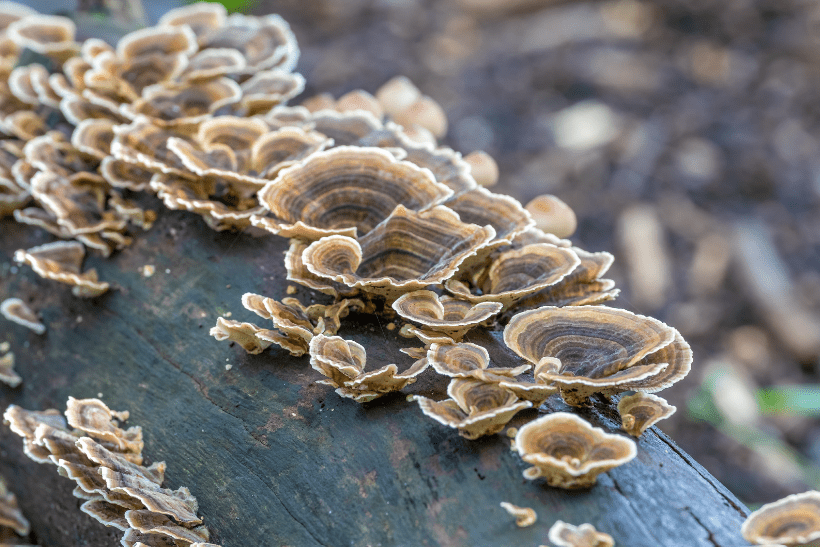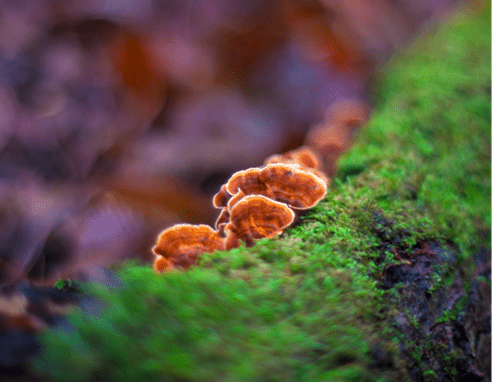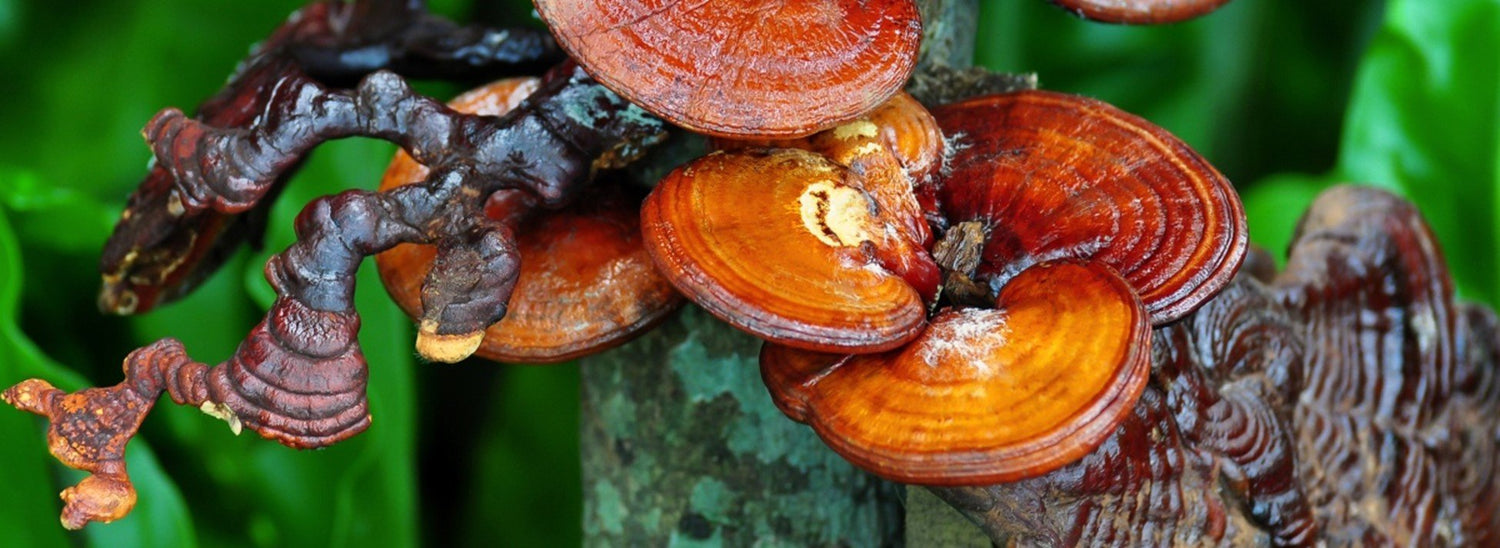Mushrooms are a fascinating species of fungi that have captured the imaginations of humans for thousands of years. From their unique shapes and colors to their delicious tastes and medicinal properties, mushrooms are truly remarkable organisms. But have you ever wondered how a mushroom comes to be? In this article, we'll explore the fungal life cycle and the stages that a mushroom goes through and help you make informed decisions about which supplements to purchase based on your individual needs and health goals.

Stage 1: Spore Germination
The life cycle of a mushroom begins with spore germination. Spores are fungi's reproductive cells released into the air by mature mushrooms. When a spore lands on a suitable surface, it begins to germinate. The spore absorbs water and nutrients from the environment, and a tiny thread-like structure called a hypha emerges.
Hyphae are the building blocks of fungi. They are long, thin, and thread-like structures that grow and branch out to form a network called mycelium. Mycelium is the vegetative part of the fungus that grows underground or within its food source. As the mycelium grows, it secretes enzymes that break down organic matter and absorb nutrients.

Stage 2: Hyphal Growth
Hyphal growth is the second stage in the life cycle of a mushroom. As the mycelium grows, it branches out and forms a network that spreads throughout its environment. This network of hyphae is essential for the survival of the fungus, as it allows it to absorb nutrients from its surroundings.
The growth of hyphae is influenced by a number of factors, including temperature, humidity, and the availability of nutrients. In order for the fungus to continue to grow, it must have access to a steady supply of food and water. This is why mushrooms are often found growing in moist, dark environments, such as forests or caves.

Stage 3: Formation of Primordia
When the mycelium has absorbed enough nutrients and environmental conditions are favourable, it begins to form primordia. Primordia are small, pin-like structures that eventually develop into mature mushrooms. They form at the tips of the mycelial threads and are often covered by a veil-like membrane.
The formation of primordia is a critical stage in the life cycle of a mushroom. It is during this stage that the fungus begins to allocate resources toward the production of reproductive structures. This is why primordia are often referred to as "baby mushrooms."
The formation of primordia is influenced by a number of factors, including temperature, humidity, and the availability of nutrients. In order for the fungus to produce healthy, mature mushrooms, it must have access to a steady supply of nutrients and water. This is why ensuring the growing environment is carefully controlled and maintained is important.

Stage 4: Maturation of the Mushroom
As the primordia continue to grow, they develop into mature mushrooms. During this stage, the mushroom undergoes rapid growth and development. The cap of the mushroom expands and the gills or pores underneath the cap mature, producing spores that will eventually be released into the air.
The maturation of the mushroom is a complex process that involves the production of a variety of different chemicals and enzymes. These chemicals and enzymes are responsible for the unique flavors and aromas that are associated with different types of mushrooms.
The maturation of the mushroom is also influenced by a number of environmental factors, including temperature, humidity, and light. For example, some types of mushrooms require a period of cold temperatures in order to fully mature.

Stage 5: Spore Release
The final stage of the fungal life cycle is spore release. Mature mushrooms release their spores into the air, where they can be carried by wind or other means to new locations. The spores can then germinate and begin the life cycle anew.
Spore release is a critical stage in the life cycle of a mushroom, as it allows the fungus to spread and colonize new environments. However, spore release can also be influenced by environmental factors, such as wind and humidity. For example, a lack of wind can prevent spores from being dispersed over long distances.

Why should we understand the stages of the mushroom cycle?
Understanding the stages of the mushroom life cycle is important can be beneficial when looking for the right reishi supplement for a number of reasons:
- Harvesting time: The stage of the mushroom cycle when the mushroom is harvested can impact its nutritional content and potency. For example, certain stages of the mushroom cycle may contain more beta-glucans, which are important components of reishi supplements known for their immune-boosting properties.

- Quality control: Understanding the stages of the mushroom cycle can help ensure that the reishi supplement is made from high-quality, properly cultivated mushrooms. By knowing what to look for in terms of harvesting and cultivation practices, consumers can make more informed decisions about which supplements to purchase.
- Potency and efficacy: Reishi supplements can vary in potency and efficacy depending on the stage of the mushroom cycle from which they are derived. By understanding the stages of the mushroom cycle, consumers can choose supplements that are better suited to their individual needs and health goals.
- Avoiding contaminants: Knowing the stages of the mushroom cycle can help identify when the mushrooms have been exposed to contaminants such as heavy metals or pesticides. This can help consumers avoid supplements that may be harmful to their health.
Understanding the stages of the mushroom life cycle is essential when choosing the right supplement, as it can affect the supplement's nutritional content, quality control, potency, efficacy, and safety. Vita Green Lingzhi's 'reishi' supplement uses mushrooms harvested from the mountain forests of Asia, ensuring that the mushrooms used are of the highest quality and free from any pollutants or heavy metals.

The Unique Benefits of Handpicked, High-Quality Mushrooms
One of the key reasons why Vita Green Lingzhi is so unique and effective is because it utilizes mushrooms that are handpicked one by one from the forest where the mushroom grows in soil and air that are all from nature. This process ensures that the mushrooms are grown in an environment that is free from any pollutants or heavy metals, guaranteeing that they are of the highest quality and safe for consumption.
Vita Green Lingzhi ensures that the mushrooms used in its supplement are harvested at the optimal stage of their growth cycle, containing the most potent and effective mushroom extracts, including high levels of beta-glucans and antioxidants. Beta-glucans are known for their immune-boosting properties, while antioxidants help to protect the body against damage caused by free radicals. With its rich content of beneficial compounds, Vita Green Lingzhi is an excellent choice for those looking to support their immune system and overall health and wellbeing.

In conclusion, understanding the stages of the mushroom life cycle is important for appreciating the remarkable journey of this fascinating organism. It can also help in selecting the right reishi supplement by ensuring that it is of high quality and free from contaminants. Vita Green Lingzhi's 'reishi' supplement is an example of a supplement that utilizes mushrooms harvested from the mountain forests of Asia, ensuring that they are of the highest quality. By understanding the stages of the mushroom cycle, consumers can make informed decisions about which supplements to purchase based on their individual needs and health goals. With its high levels of beta-glucans and antioxidants, Vita Green Lingzhi can be a good option for those looking to support their immune system and overall health and well-being.
Reference:
"The Fungal Kingdom." Mycological Society of America, www.msafungi.org/fungi/fungal-kingdom.
"The Life Cycle of Fungi." Biology Wise, www.biologywise.com/fungal-life-cycle.
Alexopoulos, C. J., Mims, C. W., & Blackwell, M. Introductory mycology. 4th ed., Wiley, 1996.
"The Life Cycle of a Mushroom." Mushroom Appreciation, mushroom-appreciation.com/life-cycle-of-a-mushroom.
"How Do Mushrooms Grow?" Mushroom Council, www.mushroomcouncil.com/how-mushrooms-grow.
"Mushroom Cultivation: The Life Cycle of Mushrooms." Fungi Ally, www.fungially.com/blogs/guides/mushroom-cultivation-the-life-cycle-of-mushrooms.
"The Lifecycle of a Fungi." University of Wisconsin-Madison, www.botany.wisc.edu/courses/botany_130/Lectures/Fungi/fungi_life_cycle.htm.
"From Spore to Fruiting Body: The Life Cycle of a Mushroom." ScienceDaily, www.sciencedaily.com/releases/2012/06/120621125339.htm.
"Mushroom Life Cycle." Cornell Mushroom Blog, mushroomblog.cals.cornell.edu/mushroom-life-cycle.
"Fungal Development and Life Cycle." The Plant Cell, American Society of Plant Biologists, vol. 14, suppl. 1, 2002, pp. S3.1-S3.19.







